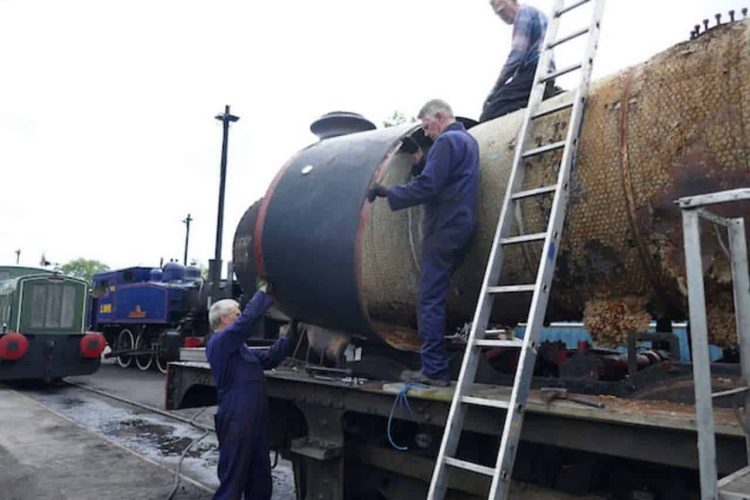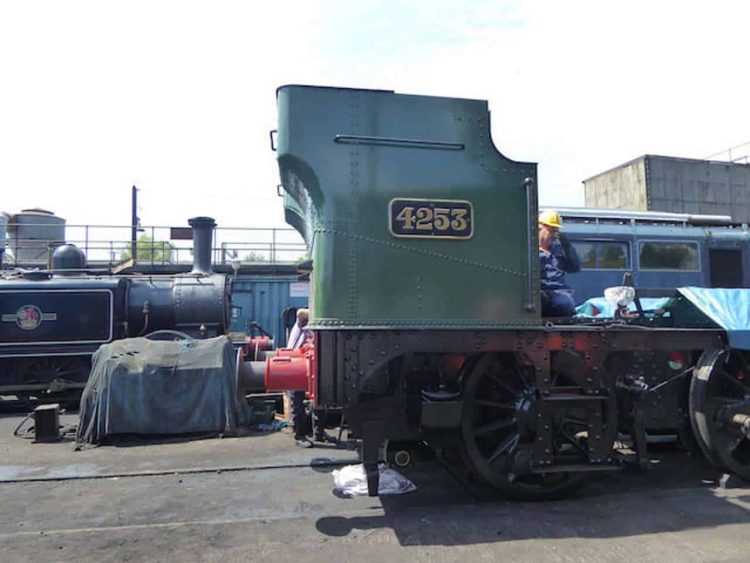On Sunday, 2nd June, the group that is restoring former Great Western Railway 2-8-0 tank engine No. 4253, the 4253 Locomotive Company, received the welcome announcement that the Rother Valley Railway Heritage Trust wished to make further investment in the company.
The announcement was made during the Kent & East Sussex Railway’s 50th Anniversary Gala, with 4253 expected to play a major role in running and operating the line when it extends from Robertsbridge to connect with the Kent & East Sussex Railway at Tenterden.

After the announcement, Charlie Masterson, Chairman of the 4253 Locomotive Company, thanked Richard Broyd CBE, a Rother Valley Railway Trustee, for the Trust’s further substantial financial input to the restoration of 4253 and presented him with a certificate in recognition.
The additional investment by the Rother Valley Railway shows it is confident that the 4253 Locomotive Company can complete the restoration of 4253 in time for the reopening of the line.
Once the line has reopened, 4253 is expected to play a major part in the operation of services between Robertsbridge and Tenterden.
A major contribution to the increased restoration costs has been a substantial increase in the cost of rebuilding 4253’s boiler, which have rocketed in the last two or three years.
The investment by the Rother Valley Railway will go a long way to ensuring the completion and installation of the boiler. It will also ease a large financial ‘black hole’ that continues to develop around it.

History
4253 was designed by George Jackson Churchward for the Great Western Railway in March 1917 to haul long and heavy coal trains through the Welsh valleys.
The terrain and weight of the trains required a locomotive with good steaming capabilities and formidable tractive effort. Throughout its working life 4253 was allocated to Newport (Pill) shed in the city’s docks.
It spent all its life hauling heavy coal trains from the pits in the Eastern and Western Valleys to the docks and the steelworks.
When diesels took over its duties in 1963, it was withdrawn and consigned, like many of its class, to the infamous Barry Scrap Yard for cutting up.

Thankfully, because of the Beeching modernisation plan, there was plenty of redundant rolling stock and track to be recycled, and 4253 never succumbed to the cutter’s torch.
In 1987 it was rescued by The Pontypool and Blaenavon Railway, but due to a lack of resources, it remained unrestored until June 2011 when it was transferred to its present home at the Kent and East Sussex Railway.
Although the all-important finance from shareholders will still be needed as we go forward to a steaming date and beyond, this additional confidence in us by the RVR will help to underpin the future of 4253 in the long term and I would like to thank them for their continued support.
Charlie Masterson, Chairman of the 4253 Locomotive Company





Responses
Woodhams sold the engines to preservationists for a considerable sum of money simply because in the government’s eyes Woodhams had broken their contract with BR for they were contracted to scrap all the steam engines they bought and not to sell them to preservationists. So the government applied a fine to every steam loco that Woodhams sold. They sold one 9F for 10K but the fine was 8K so Woodhams only made 2K out of the sale. They did cut up one 9F in the later years which had been the subject of a rescue attempt by some people in the Corby area but had been dropped and it was 92085. There was one time when Dai was saying he’d have to start cutting the engines when he didn’t get the contract for the Coke fleet of wagons. A Merchant Navy and West Country’s were nearest to the cutting area. The Coke fleet went to a scrap yard in the Cardiff area because the transportation charges were less.
To say Woodhams was an infamous scrapyard would only apply if you loved old wagons but as far as steam engines are concerned Woodhams was a saviour for so many steam engines but only because there was a never ending flow of wagons to scrap. If not for the wagons then so many of the preserved steam locos we see today would have been cut up for scrap.
Notable engines from Woodhams are two S&D 7F’s Duke of Gloucester, a B1 and a King. No Grange survived the cutters torch simply because none were ever sent to Woodhams. Dai only sold his scrapped wagons to private steelworks not government owned ones.
The two people to whom the railway preservation movement in the UK owes most are Tom Rolt and Dai Woodham.
There many scrapyards to which a pejorative adjective such as ‘infamous’ could reasonably be applied with reference to the final elimination of steam, but that of Dai Woodham emphatically ain’t amongst them. Without that Barry Island haven for fallen locos, the numbers of operable standard gauge locos would be little better than our neighbours across the Irish Sea enjoy.
Of 297 locos bought for scrapping by Woodham, no fewer than 213 made it out again and the number of those actually broken up, the vast majority went ahead of BR banning movement of locos in scap condition over it’s metals in the mid 1970s.
We COULD have had at least three mainline diesels from Barry too … an NBL Class 21 and two 41 Warship locos weren’t cut up until 1980, between wagon supplies drying up and the final few steamers lost. With incidents of parts stolen over the years, Dai Woodham’s continuing cooperation with efforts to purchase locos for preservation says much. I assure you, I’d have been far more “Monty Burns” with the thieving ratbags.
So …. Infamous? Hardly. That was every other (non-Scottish) scrapyard throughout the land, NOT Woodham Brothers Ltd., to whom every steam railway enthusiast (and incidentally, every journalist earning a crust reporting the heritage railway scene) ought to be grateful.
My son loves stream locomotives .
Great to hear another Steamer is on its way as for why Barrie Scrapyard is infamous it was the site of a good many engines being cut up long before the Restoration and Private railway groups got into gear. Some very large and famous engines sadly went to the metal recyclers heaven hence the infamy label luckily one of their number saw far ahead after enquiries came in from Museums and Rail enthusiasts about buying Parts and engines complete he was quick enough to slow then halt the least favourite operation of the Scrapyard. He was no fan of Beechings cuts but was also aware Steam was no longer commercial, that many engines were truly past the sell by date as British Rail decided that with each breakdown the yard was the new home.
I asked a question at York Station when seeing one of the last Napier Deltic Engines in the Station waiting to go, I got up onto the footplate desperately wanting to visit the superb engine room only to be told, “Sorry Sir except for the two destined to be saved all others have been sealed, if they breakdown that’s the end of it off to the scrappy it’ll go”
It was a pleasure years later to find more than two survived then have the pleasure of seeing one stripped to its frames being fully restored. I then had the pleasure of being on its first run. Not steam but still classic.
IIRC, it was Cashmore’s, just along the coast from Barry, where one day in the mid 1960s a large red engine arrived. 46256 Sir William A Stanier FRS was one of the final pair of Coronation class, built to George Ivatt’s modified design and one of the very last locos completed by the LMS before nationalisation.
It’s been claimed it’s arrival at the scrap yard was the only time any steam loco’s fate was double-checked ahead of the torches being lit Regrettably, history tells us the answer.which came back. :=(
I sincerely hope that you are successful with the restoration of a Churchward loco. Very worthwhile
Why is Barry scrapyard infamous? Surely famous and its mainly restored engines have given enormous pleasure